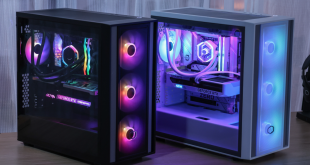A roomy interior allows the Phantom 820 to house XL-ATX motherboards, Quad-VGA configurations and multiple watercooling radiators.
The large cut-out gives users easy access to the rear of their motherboard; this makes removing a CPU cooler a quicker task.
NZXT supplies a black, braided 8-pin extension cable with the Phantom 820. Its roles are to assist CPU power cable routing for PSUs with shorter leads, and, thanks to the black braiding, to improve a finished system's aesthetic appeal.
A total of ten cut-outs with grommets and a further two routing holes give users plenty of options when undergoing the task of managing cables. The holes are appropriately positioned for ATX and XL-ATX motherboard users, but m-ATX systems will be less tidy due to the grommet placement for front panel cables.
NZXT ensures that the same high quality design and appearance is present inside the case by giving the internal materials an identical Gun Metal colour coating.
A pair of drive cages can house up to six 3.5/2.5″ devices. Removing the lower, two-bay drive cage opens up additional room for a thick 240/280mm radiator with fans. If extra space is required, the upper, four-bay drive cage can also be removed by modders, but this isn't a simple procedure and could potentially void the case's warranty.
Secured to the upper drive cage is a 120/140 mm fan mount which can swivel. Using a fan in this location can help to provide the expansion slot area with the extra air that may be required by multi-VGA configurations.
The drives cages are loaded from behind the motherboard tray, meaning that only one side panel requires removal when installing a drive.
Six rubber feet help to dampen the noise-causing vibrations that exit the power supply. Units up to 230mm in length can be used without interfering with a bottom-mounted 140mm fan. If no fans are installed in the bottom mounting location, the NZXT Phantom 820 will house any ATX power supply on the market.
Five rubber grommets are located within inches of the power supply area. This makes cable routing a far simpler and more effective task.
Nine tool-less, vented expansion slots indicate the Phantom 820's ability to house XL-ATX motherboards, or four-way graphics configurations on ATX boards.
The 140mm rear exhaust fan can be moved up or down the mount, allowing users to situate it in their preferred location. The adjustable mounting location also gives additional flexibility when using a 120/140mm radiator in the rear location; interferences can be avoided.
NZXT provides another of its 30mm-thick, 200mm exhaust fans in the roof mounting location. This area can hold up to two 140/200 mm or three 120 mm fans. The fans are actually mounted in an area outside of the case's internal compartment, directly underneath the exterior roof panel.
Thanks to the unique fan mounting location, 70-75mm of internal clearance above the motherboard area, and removable upper 5.25″ bay, the Phantom 820 can easily house thick radiators with a push/pull setup. Mounting intake fans in the roof area won't be a problem either; a pair of 200mm filters will prevent internal dust build-up.
Removing the front panel is a procedure that NZXT has made more difficult than it needs to be. Users are forced to remove both side covers and unclip the front panel from the inside. Once unclipped, the front panel can be placed out of the way, thanks to the fact that the IO cables are mounted to the case itself.
Thankfully, the front panel doesn't have to be removed every time a 5.25″ device is installed, but it does provide access to the front fan's filter, making removing the dust an inconvenient chore.
If removing the front panel was bad, the roof removal procedure is even worse. NZXT forces you to remove the front panel before the roof. This leaves us with both side panels and the front panel removed.
While removing the roof for hardware installation may be an intermittent task, as with the front panel, cleaning the dust filters is a chore that is made far more laborious due to the awkwardness of accessing them.
 KitGuru KitGuru.net – Tech News | Hardware News | Hardware Reviews | IOS | Mobile | Gaming | Graphics Cards
KitGuru KitGuru.net – Tech News | Hardware News | Hardware Reviews | IOS | Mobile | Gaming | Graphics Cards













